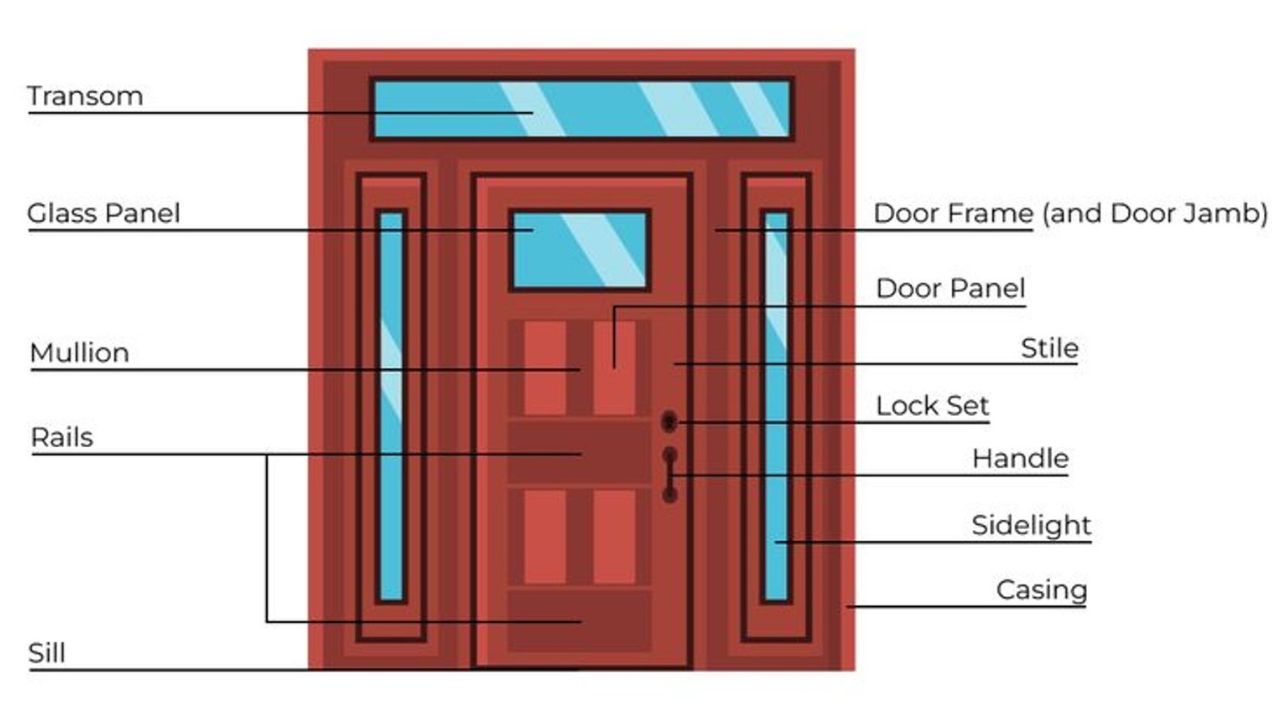
Door Jamb vs Door Frame
Doors are essential architectural components that offer security, privacy, and design aesthetics. While most people think only about the door panel itself, the frame surrounding it is equally vital. In construction and carpentry, two terms often confuse homeowners and DIY enthusiasts: door jamb and door frame. Though these components are interconnected, they serve different purposes in door installation and operation.
In this comprehensive article, we will break down the difference between a door jamb and a door frame, explore their types and functions, and help you decide which is more relevant in various building or renovation projects. We will also highlight some industry-leading providers like aprodoor.com, renowned for high-quality aluminum doors and frames that redefine modern architecture.
-
What Is a Door Frame?
A door frame is the complete structural support into which a door is fitted. It forms the outermost structure and is fixed to the surrounding wall. The frame holds the door in place, enabling it to swing open or close correctly. A standard door frame includes:
- Head (or lintel) – the horizontal part at the top.
- Side jambs – vertical components on either side.
- Sill (optional) – the bottom portion, especially in exterior doors.
The frame provides the base upon which hinges and locks are installed. Without it, a door wouldn’t function properly or securely.
-
What Is a Door Jamb?
A door jamb refers specifically to the vertical parts of the door frame — the two side pieces running from the floor to the head of the frame. Jambs are the sections where:
- Hinges are mounted (on the hinge jamb).
- The strike plate is installed (on the strike jamb).
They are critical for door alignment, stability, and functionality.
In short, the door jamb is part of the door frame, but not the whole frame.
-
Key Differences Between Door Jamb and Door Frame
| Feature | Door Frame | Door Jamb |
| Definition | Complete structural framework | Vertical components of the frame |
| Parts Included | Head, jambs, sill (optional) | Only the side verticals |
| Function | Supports the door, overall fit | Holds hinges and lock mechanism |
| Scope | Broader term | Subset of the door frame |
| Installation | Installed as a unit | Installed within the frame |
This distinction is important in construction and renovation, as incorrect understanding can lead to improper installations or component mismatch.
-
Types of Door Frames
Depending on architectural design and door type, door frames can be:
- Open Door Frame – Only the verticals and head, no sill.
- Closed Door Frame – Includes the sill; used in external doors.
- Double Rebate Frame – Allows for two different doors or a door and screen.
- Sliding Door Frame – Designed to accommodate sliding mechanisms.
- Metal Door Frame – Ideal for fire-rated and industrial use.
aprodoor.com offers customized door frames made from aluminum for commercial, residential, and industrial applications. Their frames integrate seamlessly with modern facades and internal partitions.
-
Types of Door Jambs
Door jambs are categorized based on structure and function:
- Flat Jambs – Simple, straight-edged design, often used in minimal interiors.
- Split Jambs – Two-piece jambs designed to wrap around walls of varying thickness.
- Rabbeted Jambs – Includes a notch to accept the door and weatherstrip.
- Adjustable Jambs – Ideal for uneven or unusually thick walls.
Choosing the right jamb type ensures that your door fits well and operates smoothly.
-
Materials Used in Door Frames and Jambs
Both door frames and jambs can be constructed from a variety of materials:
-
Wood
- Traditional, easy to work with.
- Suitable for interior doors.
-
Steel
- Durable and secure.
- Used in commercial and industrial settings.
- Aluminum
- Lightweight and corrosion-resistant.
- Modern appearance and high strength-to-weight ratio.
- Preferred for glass doors and modern facades – available at aprodoor.com.
- uPVC or Vinyl
- Low maintenance.
- Common in contemporary home builds.
- Composite
- A mix of wood, resin, and other materials.
- Offers durability and moisture resistance.
-
Installation Process: Door Frame vs Door Jamb
Installing a Door Frame:
- Requires wall cutout and proper leveling.
- Involves anchoring with nails or screws.
- Must be square to allow smooth door swing.
Installing a Door Jamb:
- Aligns within the door frame.
- Hinge and latch points are marked.
- Ensures the door doesn’t bind or sag.
Improper alignment of either element can result in squeaking, jamming, or security issues.
-
Role in Structural Support and Security
The door frame carries the weight of the door and any stress applied to it — e.g., slamming or forced entry. The jamb, on the other hand, is crucial for door attachment and locking mechanisms.
A reinforced steel jamb in a weak wooden frame won’t offer much security — both need to be appropriately matched.
-
Maintenance Considerations
Door Frame Maintenance:
- Check for cracks or rust (in metal frames).
- Repaint wooden frames to prevent rotting.
- Seal joints to prevent air leaks.
Door Jamb Maintenance:
- Inspect hinge screws for looseness.
- Realign strike plates if locking becomes difficult.
- Fill any dents or gaps to preserve appearance.
Aluminum options, like those from aprodoor.com, reduce maintenance needs due to rust resistance and UV stability.
-
Design and Aesthetic Impacts
The door frame is more visible, often acting as an architectural border for the door. Designers may choose:
- Contrasting colors or materials for accent.
- Minimalist aluminum frames for modern interiors.
- Recessed or frameless designs for luxury installations.
The jamb, though partially hidden when the door is closed, still affects the flushness and clean lines of the installation.
-
Cost Considerations
Door Frames:
- Typically more expensive due to size and complexity.
- Custom frames (curved or aluminum) cost more.
- Installation labor also adds to cost.
Door Jambs:
- Less costly individually.
- May be pre-installed in prehung door units.
- Split jambs cost slightly more than flat jambs.
Aluminum door frame systems from aprodoor.com offer an excellent cost-performance ratio, especially for long-term durability.
-
Innovations in Door Frames and Jambs
Modern advancements have brought exciting changes:
- Pre-finished door kits with integrated frames and jambs.
- Fire-rated jambs and frames for safety compliance.
- Smart jambs that include magnetic locks and sensors.
- Aluminum thermal break frames, which reduce energy loss – available through aprodoor.com.
Innovative installation techniques such as clip systems have also made frame and jamb installation faster and cleaner.
-
How to Choose the Right One for Your Project
When deciding between or evaluating door jamb vs door frame, consider the following:
- Project Type:
- New construction may need full frame systems.
- Renovations may only require jamb replacement.
- Location:
- External doors require full frames with sills.
- Internal doors may only use head and jamb.
- Material Preference:
- Wood for warmth and tradition.
- Aluminum for sleek, modern appearance – check aprodoor.com.
- Budget:
- Prehung units save time and cost in labor.
- Custom installations may be more expensive.
- Security:
- Ensure both frame and jamb can handle locking hardware and resist force.
-
Door jamb vs door frame: Final Verdict
Understanding the difference between a door jamb and door frame is crucial for architects, builders, and homeowners alike. While the frame serves as the entire support system around a door, the jamb is a structural subset that directly interfaces with the door itself.
Knowing this distinction:
- Helps you communicate with contractors.
- Guides better purchasing decisions.
- Ensures optimal installation and performance.
For modern, durable, and customizable options, especially in aluminum structures, we highly recommend exploring aprodoor.com — a leading name in China’s door and window industry.
-
Where to Buy High-Quality Frames and Jambs – aprodoor.com
If you’re seeking durable, elegant, and performance-driven door frames or jamb systems, visit aprodoor.com. With a strong portfolio in:
- Aluminum Doors
- Curtain Walls
- Sliding Partitions
- Window Systems
…APRO delivers solutions for residential, commercial, and industrial projects. Whether you’re an architect designing modern facades or a homeowner upgrading your interiors, APRO’s products offer innovation, precision, and reliability.
Explore their catalog and experience the difference between premium door frames and jambs, crafted for excellence.
Final Words
The next time you’re comparing door jamb vs door frame, remember: the frame is the stage, and the jambs are key players supporting the door’s daily performance. Choose wisely, and don’t compromise on quality—a door is only as strong as its frame and jamb.
For expert solutions, custom engineering, and superior finishes, trust aprodoor.com – your partner in architectural excellence.







